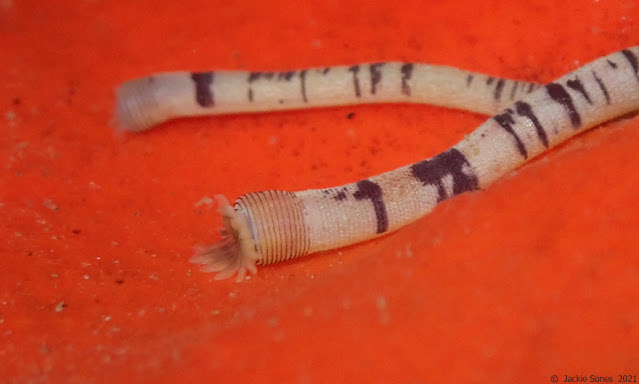Here's an extreme close-up. Do you have any guesses about what type of organism this is?
This is hard, but it's one of the animals that was in the holdfast post a few nights ago. Here's another hint:
This is a sipunculan, commonly known as a peanut worm. These pictures show the most frequently encountered species of peanut worm on Bodega Head, Phascolosoma agassizii. Alhough often hidden, they're common in intertidal mussel beds and can also be found in rock crevices, kelp holdfasts, and among surfgrass roots.
Externally, you can see two main body parts: the trunk, which is the main portion of the body containing most of the organs; and the introvert, which is long and narrow. The introvert is extensible —
it can be much longer than the trunk when fully extended.
Note that the skin is papillated (bumpy). And there are rounded spots on the trunk and dark linear pigment bands on the introvert.
Once the introvert starts to extend, it happens pretty quickly (it's fast enough that it's hard to photograph under a microscope!).
Amazingly, the introvert can be fully retracted into the trunk. Because this was a very small individual and somewhat transparent, you can actually see the introvert inside of the trunk in the image below. Look for the dark pigment bands visible under the skin.
Although not illustrated in the pictures above, the very tip of the introvert has a tentacular crown (ring of tentacles) used in feeding and gas exchange. The next photo shows a peanut worm using its tentacles to gather food (detritus) in a tidepool.
I often see peanut worms in crevices. In his book, Invertebrates, Eugene Kozloff says, "They like tight situations into which their bodies fit almost perfectly."
Below is a view of peanut worms in a shallow, water-filled crevice (only their introverts are visible). How many peanut worms can you find?
There are three peanut worms in the photo above —
two larger individuals and one very small juvenile. The inset below shows you where the little one is. (When the introvert is retracted, the average length of local peanut worms is ~2-3 cm.)
I don't know if anyone has ever tried, but it seems like the banding patterns on the introverts could be used to identify individual peanut worms (like fluke patterns in Humpback Whales!).

















































